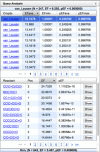AnchorQuery: Rapid online virtual screening for small-molecule protein-protein interaction inhibitors
- PMID: 28921842
- PMCID: PMC5734307
- DOI: 10.1002/pro.3303
AnchorQuery: Rapid online virtual screening for small-molecule protein-protein interaction inhibitors
Abstract
AnchorQuery (http://anchorquery.csb.pitt.edu) is a web application for rational structure-based design of protein-protein interaction (PPI) inhibitors. A specialized variant of pharmacophore search is used to rapidly screen libraries consisting of more than 31 million synthesizable compounds biased by design to preferentially target PPIs. Every library compound is accessible through one-step multi-component reaction (MCR) chemistry and contains an anchor motif that is bioisosteric to an amino acid residue. The inclusion of this anchor not only biases the compounds to interact with proteins, it also enables a rapid, sublinear time pharmacophore search algorithm. AnchorQuery provides all the tools necessary for users to perform online interactive virtual screens of millions of compounds, including pharmacophore elucidation and search, and enrichment analysis. Accessibility: AnchorQuery is freely accessible at http://anchorquery.csb.pitt.edu.
Keywords: compound libraries; multicomponent reactions; pharmacophore; small-molecules; virtual screening.
© 2017 The Protein Society.
Figures



References
Publication types
MeSH terms
Associated data
- Actions
Grants and funding
LinkOut - more resources
Full Text Sources
Other Literature Sources

